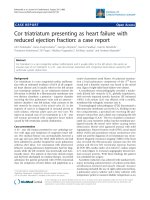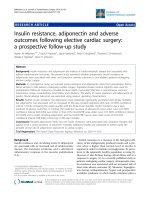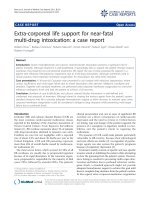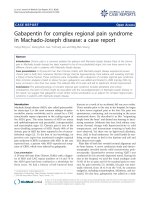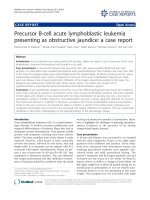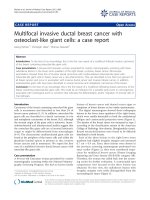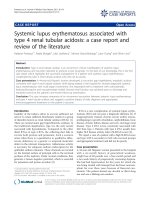Báo cáo y học: " Tako-tsubo cardiomyopathy after administration of ergometrine following elective caesarean delivery: a case report" pptx
Bạn đang xem bản rút gọn của tài liệu. Xem và tải ngay bản đầy đủ của tài liệu tại đây (925.1 KB, 4 trang )
CAS E REP O R T Open Access
Tako-tsubo cardiomyopathy after administration
of ergometrine following elective caesarean
delivery: a case report
Abdulgazi Keskin
*
, Ralph Winkler, Bernd Mark, Andreas Kilkowski, Timm Bauer, Oliver Koeth, Selcan Camci,
Bernd Cornelius, Günther Layer, Uwe Zeymer, Ralf Zahn
Abstract
Introduction: Tako-tsubo cardiomyopathy (stress-induced cardiomyopathy or transient left ventricular ballooning)
is characterized by clinical suspicion of an acute myocardial infarction with transient apical or midventricular
dyskinesia of the left ventricle without significant coronary stenosis on angiography. The etiology of this disease
remains obscure. One of the possible causes is myocardial ischemia induced by coronary vasospasm due to
sympathetic activation. It has been hypothesized that the application of ergometrine could induce tako-t subo
cardiomyopathy.
Case presentation: We report the case of a 28-year-old Turkish woman who developed tako-tsubo
cardiomyopathy after administration of ergometrine for release of placenta and prevention of bleeding during the
post-partum phase in the course of an elective caesarean delivery. Tako-tsubo cardiomyopathy was diagnosed by
echocardiography and urgent cardiac magnetic resonance imaging. A coronary angiography was not performed
because of the absence of myocardial necrosis or ischemia and signs of myocarditis on cardiac magnetic
resonance imaging.
Conclusion: This life-threatening disease should be excluded in the differential diagnosis by comparing the
symptoms with those of typical heart failure, particularly after use of ergometrine.
Introduction
Since the first description in 1991 by Dote et al.,[1], an
increasing number of reports of tako-tsubo cardiomyopa-
thy (CMP) have been published. This disease is typically
seen in postmenopausal women aged from 58 to 77 years
[2]. It is also present in about 1.2% of cases of troponin-
positive acute coronary syndrome, with an atypical (mid-
ventricular) pattern found in 40% of those cases with
tako-tsubo cardiomyopathy (1.2%). Intrahospital mortal-
ityisnearly1%,anda30-daymortalityrateof8.6%was
reported in one study by Kurowski et al. [2].
Case presentation
A 28- year-o ld healthy Tu rkish woman (height 166 cm,
weight 75 kg), without any medical history was admitted
to a peripheral h ospital at 37 weeks gestation for an
elective caesarean delivery. During the course of the
delivery, intravenous short-term infusion of 0.2 mg
methylergometrine and 30IE oxytocin was administered
for easy release of the placenta and prevention of bleed-
ing during the post-partum phase. There were no com-
plications during delivery. Approximately 30 minutes
after delivery, the patient develope d severe distress and
chest pain. On physical examination, rales were detected
in both lungs (K illip class II). The patient was trans-
ferred to our hospital for further investigation.
On electrocardiogram, a sinus tachycardia (100 /min)
without ST-segment changes was seen. The patient’ s
blood pressure was 100/60 mmHg and her pO
2
was
52 mmHg without oxygen supp lementation. Chest x-ray
revealed seve re fluid consolidation (N-terminal prohor-
mone brain natriu retic peptide-brain natriuretic peptide
value 3900 pg/ml). Oxygen and loop diuretics rapidly
improved the p atient’s respiratory status. The initial
* Correspondence:
Department of Cardiology (Herzzentrum Ludwigshafen), Hospital
Ludwigshafen, Academic Teaching Hospital of Johannes-Gutenberg-
University of Mainz, Ludwigshafen am Rhein, Germany
Keskin et al. Journal of Medical Case Reports 2010, 4:280
/>JOURNAL OF MEDICAL
CASE REPORTS
© 2010 Keskin et al; licensee BioMed Central Ltd. This is an Open Access article distributed under the terms of the Creative Commons
Attribution Licens e ( which permits unrestr icted use, distribution, and reproduction in
any medium, provid ed the original work is properly cited.
two-dimensional echocardiography showed moderately
reduced systolic left ventricular function with a midven-
tricular hypokinesia. Left ve ntricular end diastolic dia-
meter was normal. The ejection fraction as measured by
the Simpson’s m ethod was 38%. Laboratory investiga-
tions found raised levels of troponin T (0.19 ng/ml,;
normal < 0.03 ng/mL) and creatine kinase (356 U/L;
normal < 145 U/L). T he patient was started on diuretics
and angiotensin-converting enzyme inhibitors, after
which she recovered quickly and showed no respiratory
distress or other signs of heart failure.
In the absence of any cardiovascular risk factors and
the age of the patient, we decided against using coron-
ary angiography for initial anatomic. We conducted con-
trast-enhanced cardiac magnetic resonance (CMR)
imaging, which showed a circular midventricular hypo-
kinesia and no delayed enhancement after gadolinium
application. Neither myocardial necrosis nor ischemia
were seen, therefore coronary angiography was not
performed
The patient’s cardiac enzymes normalized within three
days after admission. Two-dimensional echocardiogra-
phy showed that systolic left ventricular function had
completely recovered without any wall motion abnorm-
alities within those three days.
Based on the patient’s history with absence of cardio-
vascular ri sk factors, mild cardiac enzyme elevation and
CMR findings of midventricular hypokinesia without
necrosis and ischemia, she w as diagnosed with ta ko-
tsubo CMP. Seven days after admission, the patient and
her healthy newborn child were discharged.
Discussion
Since the first description in 1991 by Dote et al. [1], an
increasing number o f reports of tako-tsubo CMP have
been published. The condition is typically seen in post-
menopausal women in the range from 58 to 77 years
[2-4]. It is present in about 1.2% of cases of troponin-
positive acute coronary syndrome, with an atypical (mid-
ventricular) pattern being found in 40% of those cases. It
is suggested that the atypical version is a variation of
typical tako-tsubo CMP produced by early recovery of
function at the apex with apical ballooning [5]. Intrahos-
pital mortality is nearly 1%, and a 30-day mortality rate
of 8.6% was described in one study by Kurowski et al. [2].
Our case report is an atypical presentation of a mid-
ventricular tako-tsubo CMP in a 28-year-old woman
occurring within 30 minutes after use of ergometrine in
a caesarean delivery.
The suggested mechanism for tako-tsubo CMP is
myocardial ischemia induced by vascular spasm due to
sympathetic over-activation by a stressful situation [6,7].
A number of substances are known to induce
vasospasm, and as shown by this report, ergometrine
may also cause a tako-tsubo CMP. Ergometrine is a part
of the ergot family of alkaloids, and is used for treat-
ment of acute migraine attacks, to induce childbirth,
and as in our case, to prevent post-partum haemor-
rhage. Ergometrine possesses structural similarity to sev-
eral neurotransmitters, and has biological activity as a
vasoconstrictor. These effects have been shown in both
animal models and in human studies [8-10]. In the lar-
gest study, Akasaka etal. reported 26 patients with
angiographically documented normal coronary arteries
and Prinzmetal’s angina; the authors observed significant
coronary vasospasm after ergometrine administration in
all cases [10]. In our case, a combination of ergometrine
administrat ion an d an extraordinary stress situation was
present, so that the definite cause could not be isolated.
Using CMR, dyskinesia of the left ventricle extending
beyond the vascular bed of a single coronary artery
and no delayed gadolinium enhancement were seen
(Figure 1, Figure 2). A myocardial infarction was
excluded by absence of necrosis and ischemia.
To the best of our knowledge, our case rep resents the
first published report of a woman with tako-tsubo CMP
after use of ergometrine in the course of caesarean
delivery. In the literature, we found only one other case
report of tako-tsubo CMP after ergomet rine application,
but this was in a 42-year-old woman with a hematologic
disease and arterial hypertension [11].
As part of the differential diagnosis, we considered
peripartum cardiomyopathy (PPCM), a rare, l ife-threa-
tening disease of late pregnancy and the early postpar-
tum period. However, this disease is typically seen in
women with the following risk factors: age greater than
30 years,, multiparity, multiple pregnancies, African
American ethnicity, obesity, and arterial hypertension.
Hypokinesia of the left ventricle i n PPCM is diffuse
rather than segmental, and the left ventricular end-
diastol ic diameter is increased [12]. Our patient d id not
match any of these criteria, and she recovered left ven-
tricular function rapidly; this is much slower PPCM
than in tako-tsubo CMP [13].
Conclusion
Tako-tsubo CMP should be considered in the differen-
tial diagnosis for patients with symptoms of acute heart
failure particularly after use of ergometrine b y caesarean
delivery.
Consent
Written informed consent was obtained from the patient
for publication of this case report and any accompany-
ing images. A copy o f the written consent is available
for review by the Editor-in-Chief of this journal.
Keskin et al. Journal of Medical Case Reports 2010, 4:280
/>Page 2 of 4
Figure 1 Ventriculography by diastole with hypokinesia of midventricular segment (marked with white arrow).
Figure 2 Ventriculography by systole with hypokinesia of midventricular segment (marked with white arrow).
Keskin et al. Journal of Medical Case Reports 2010, 4:280
/>Page 3 of 4
Abbreviations
CMP: cardiomyopathy; CMR: cardiac magnetic resonance; ECG:
electrocardiography; PPCM: peripartum cardiomyopathy
Acknowledgements
We would like to acknowledge the Central Institute for Diagnostic and
Interventional Radiology Hospital Ludwigshafen and special thanks to
Dr. Bernd Cornelius and Prof. Dr. Günther Layer.
Authors’ contributions
AK was the assistant cardiologist who diagnosed the problem. RW and SC
collected the data and helped draft the manuscript. BC performed the
cardiac magnetic resonance. TB was a major contributor in writing the
manuscript. All authors read and approved the final manuscript.
Competing interests
The authors declare that they have no competing interests.
Received: 2 November 2009 Accepted: 20 August 2010
Published: 20 August 2010
References
1. Dote K, Sato H, Tateishi H, Uchida T, Ishihara M: Myocardial stunning due
to simultaneous multivessel coronary spasms: a review of 5 cases.
J Cardiol 1991, 21:203-214.
2. Kurowski V, Kaiser A, von Hof K, Killermann DP, Mayer B, Hartmann F,
Schunkert H, Radke PW: Apical and midventricular transient left
ventricular dysfunction syndrome (tako-tsubo cardiomyopathy):
frequency, mechanisms, and prognosis. Chest 2007, 132:809-816.
3. Gianni M, Dentali F, Grandi AM, Sumner G, Hiralal R, Lonn E: Apical
ballooning syndrome or tako-tsubo cardiomyopathy: a systematic
review. Eur Heart J 2006, 27:1523-1529.
4. Donohue D, Movahed MR: Clinical characteristics, demographics and
prognosis of transient left ventricular apical ballooning syndrome. Heart
Fail Rev 2005, 10:311-316.
5. Prasad A, Lerman A, Rihal CS: Apical ballooning syndrome (Tako-Tsubo or
stress cardiomyopathy): a mimic of acute myocardial infarction. Am
Heart J 2008, 155(3):408-417.
6. Wittstein IS, Thiemann DR, Lima JA, Baughman KL, Schulman SP,
Gerstenblith G, Wu KC, Rade JJ, Bivalacqua TJ, Champion HC:
Neurohumoral features of myocardial stunning due to sudden
emotional stress. N Engl J Med 2005, 10(352):539-548.
7. Koeth O, Mark B, Cornelius B, Senges J, Zeymer U: Cardiogenic shock after
adrenalectomy for pheochromocytoma. Internist 2007, 48:189-193.
8. Egashira K, Tomoike H, Hayashi Y, Yamada A, Nakamura M, Takeshita A:
Mechanism of ergonovine-induced hyperconstriction of the large
epicardial coronary artery in conscious dogs a month after arterial
injury. Circ Res 1992, 71:435-442.
9. Nakamura Y, Yamaguro T, Inoki I, Takemori H, Katsuki T, Takata S,
Kobayashi K: Vasomotor response to ergonovine of epicardial and
resistance coronary arteries in the nonspastic vascular bed in patients
with vasospastic angina. Am J Cardiol 1994, 15(74):1006-1010.
10. Akasaka T, Yoshida K, Hozumi T, Takagi T, Kawamoto T, Kaji S, Morioka S,
Yoshikawa J: Comparison of coronary flow reserve between focal and
diffuse vasoconstriction induced by ergonovine in patients with
vasospastic angina. Am J Cardiol 1997, 15(80):705-710.
11. Citro R, Pascotto M, Provenza G, Gregorio G, Bossone E: Transient left
ventricular ballooning (tako-tsubo cardiomyopathy) soon after
intravenous ergonovine injection following caesarean delivery. Int J
Cardiol 2008, 14:e31-e34.
12. Abboud J, Murad Y, Chen-Scarabelli C, Saravolatz L, Scarabelli TM:
Peripartum cardiomyopathy: A comprehensive review. Int J Cardiol 2007,
118(3):295-303.
13. Fett JD, Sannon H, Thélisma E, Sprunger T, Suresh V: Recovery from severe
heart failure following peripartum cardiomyopathy. Int J Gynecol Obstet
2009, 104(2):125-127.
doi:10.1186/1752-1947-4-280
Cite this article as: Keskin et al.: Tako-tsubo cardiomyopathy after
administration of ergometrine following elective caesarean delivery: a
case report. Journal of Medical Case Reports 2010 4:280.
Submit your next manuscript to BioMed Central
and take full advantage of:
• Convenient online submission
• Thorough peer review
• No space constraints or color figure charges
• Immediate publication on acceptance
• Inclusion in PubMed, CAS, Scopus and Google Scholar
• Research which is freely available for redistribution
Submit your manuscript at
www.biomedcentral.com/submit
Keskin et al. Journal of Medical Case Reports 2010, 4:280
/>Page 4 of 4

